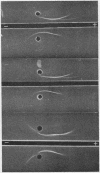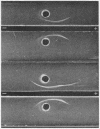Abstract
Activation of the complement sequence results in conversion of the third component of complement (C′3) to an inactive product (C′3i) and the elaboration of additional fragments of smaller molecular weights and faster electrophoretic mobilities. Immunoelectrophoretic analysis of fresh synovial fluids with an anti-human C′3 antiserum disclosed in some a variable degree of conversion of C′3 to C′3i, but a more striking finding was an additional line in the α-globulin region. This faster migrating protein gave a reaction of partial identity with C′3/C′3i. With this antiserum a similar pattern developed when fresh human serum was incubated with immune complexes, or aggregated γ-globulin. The same breakdown product of C′3 was obtained by treatment of fresh human serum with Zymosan, ammonium, hydrazine, agar, or dextran. Heating serum at 56°C for 1 hr destroys the breakdown product; aging of serum produces it.
Breakdown products of C′3 were looked for in 49 synovial fluids from patients with a variety of joint diseases. A significant correlation was found between the demonstration of the fast migrating breakdown product of C′3 and the diagnosis of rheumatoid arthritis and the presence of rheumatoid factor. A similar immunoelectrophoretic pattern was not found in the serum of any of the patients studied.
When human γ-globulin, which has been reduced and alkylated, is heat aggregated it loses the ability to fix human complement but still reacts with rheumatoid factor. Addition of reduced, aggregated γ-globulin to fresh normal human serum produced no conversion of C′3, but when incubated with serum containing a high titer of rheumatoid factor, there was conversion of C′3 and the appearance of a breakdown product. Quantitative complement fixation studies with fresh serum from normal subjects and patients with rheumatoid arthritis disclosed complement fixation by reduced, aggregated γ-globulin. The per cent of complement fixation was proportional to the titer of rheumatoid factor present in the test serum. These findings were interpreted as showing that rheumatoid factor can fix complement.
The possibility is discussed that the presence of breakdown products of C′3 in the synovial effusions of most patients with seropositive rheumatoid arthritis and the ability of rheumatoid factor to fix complement are related phenomena.
Full text
PDF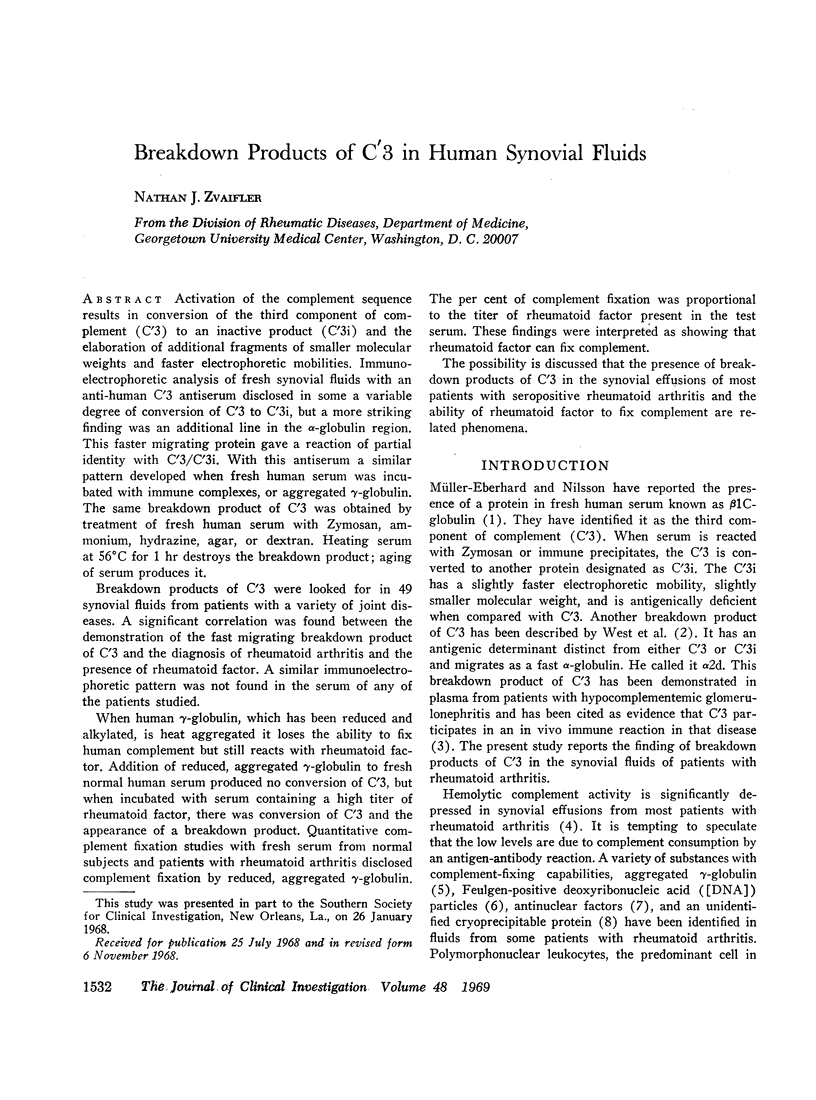

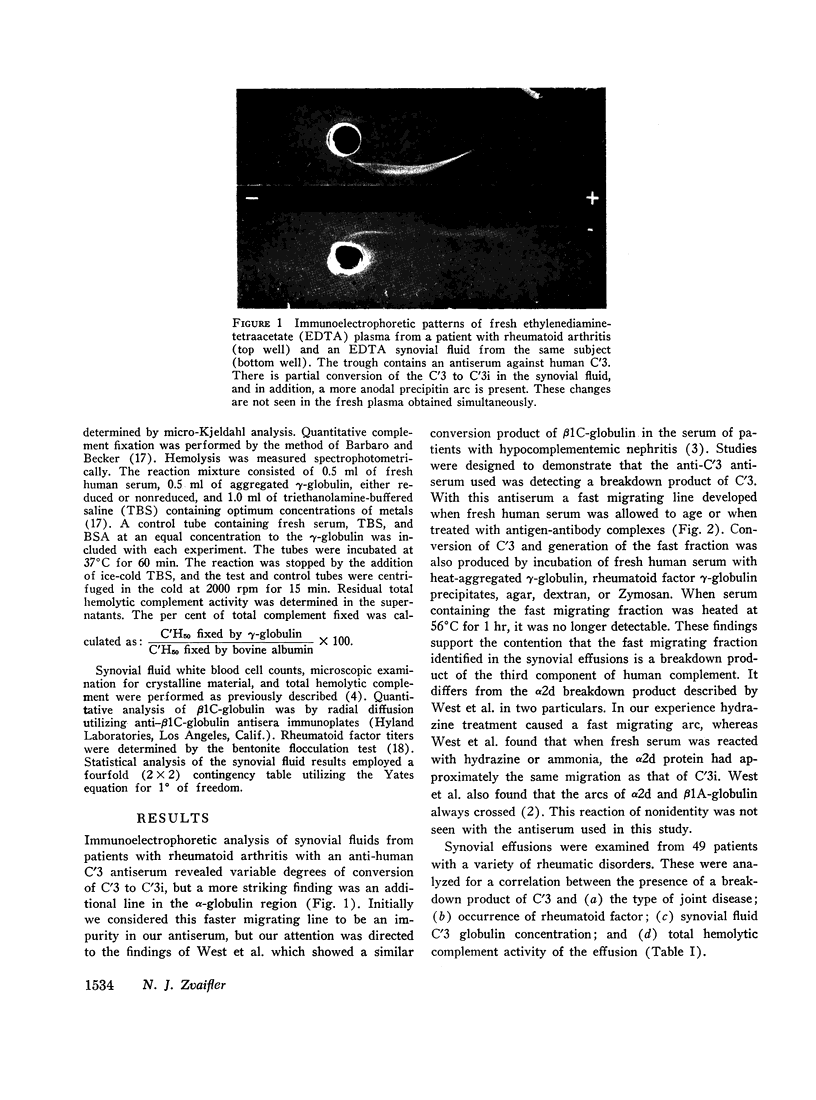
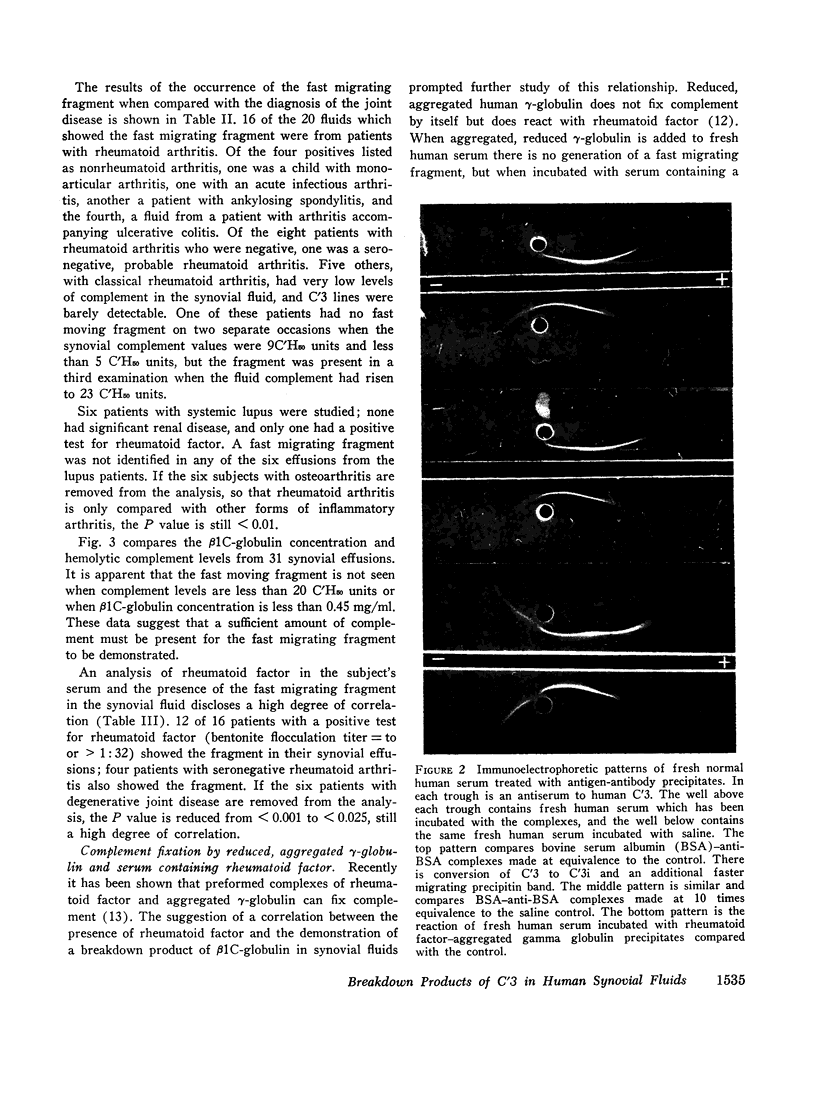
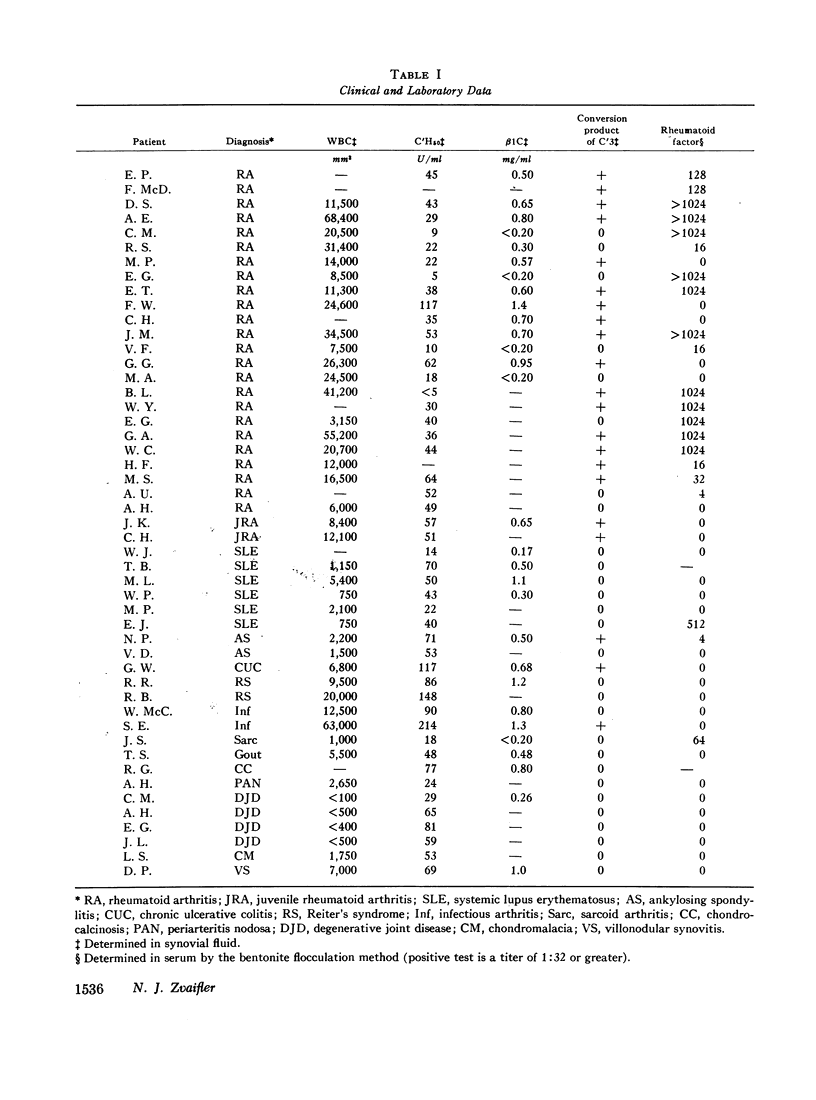
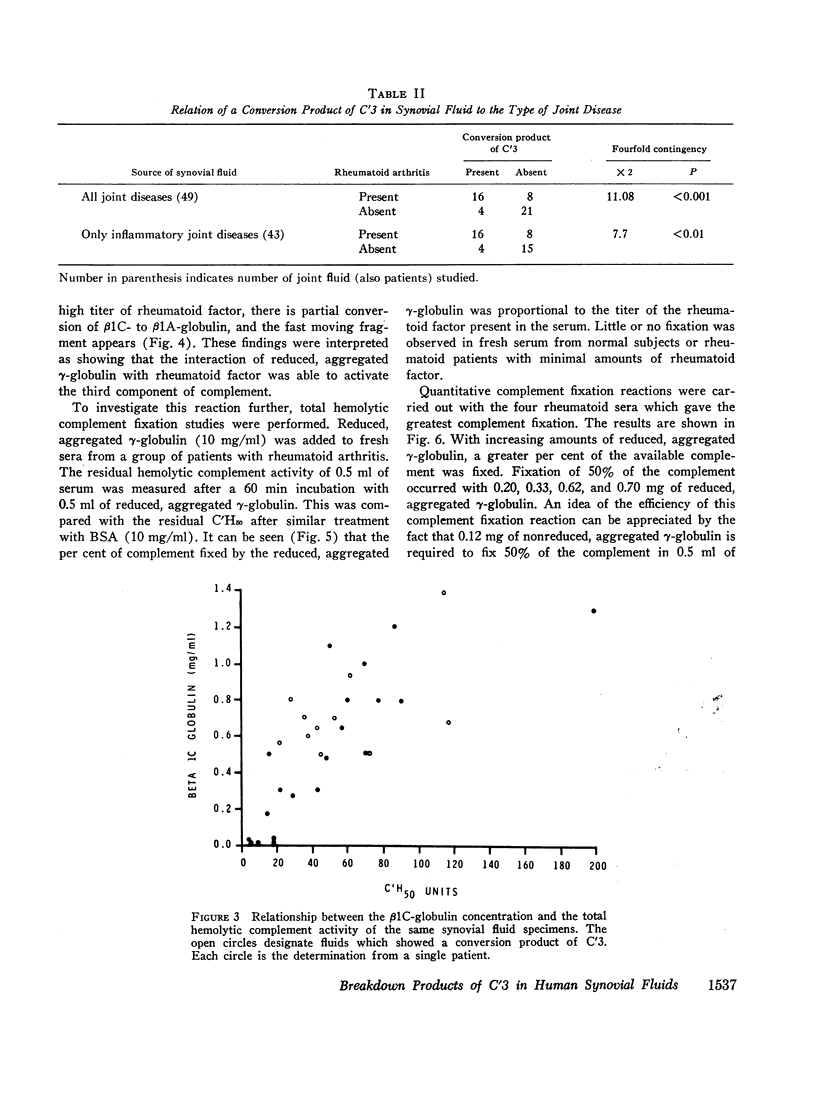
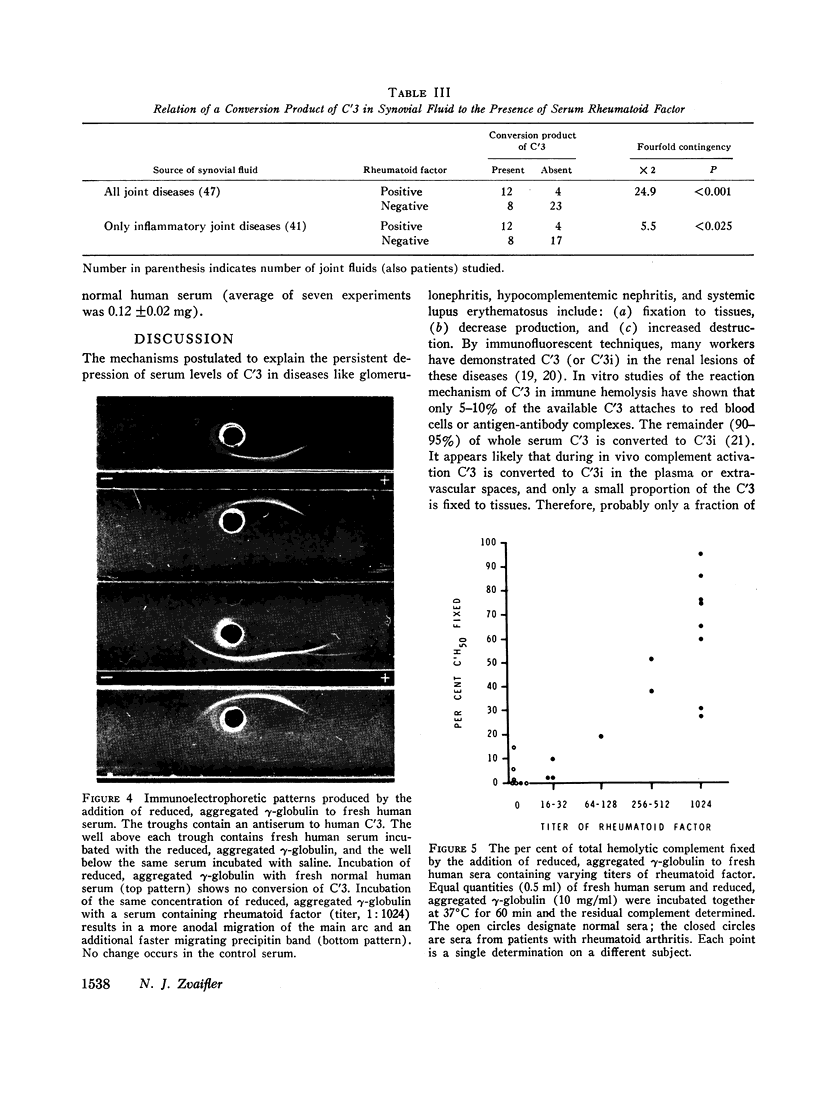
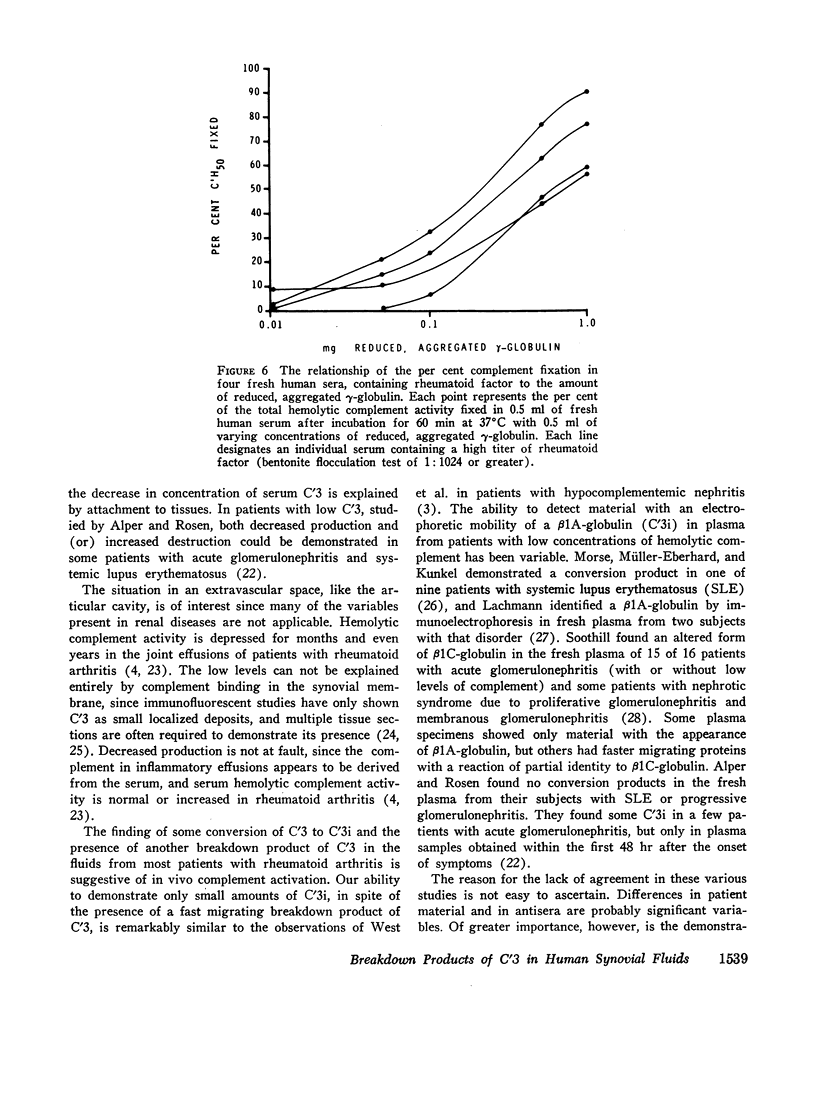
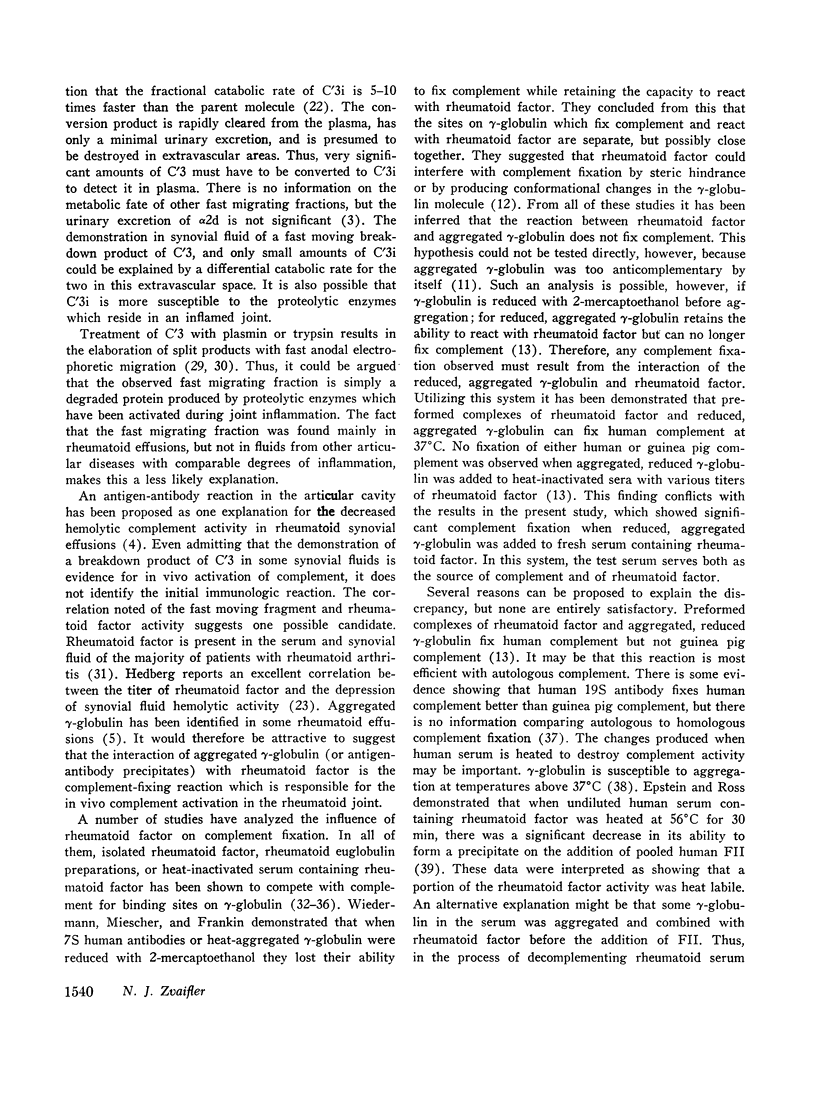
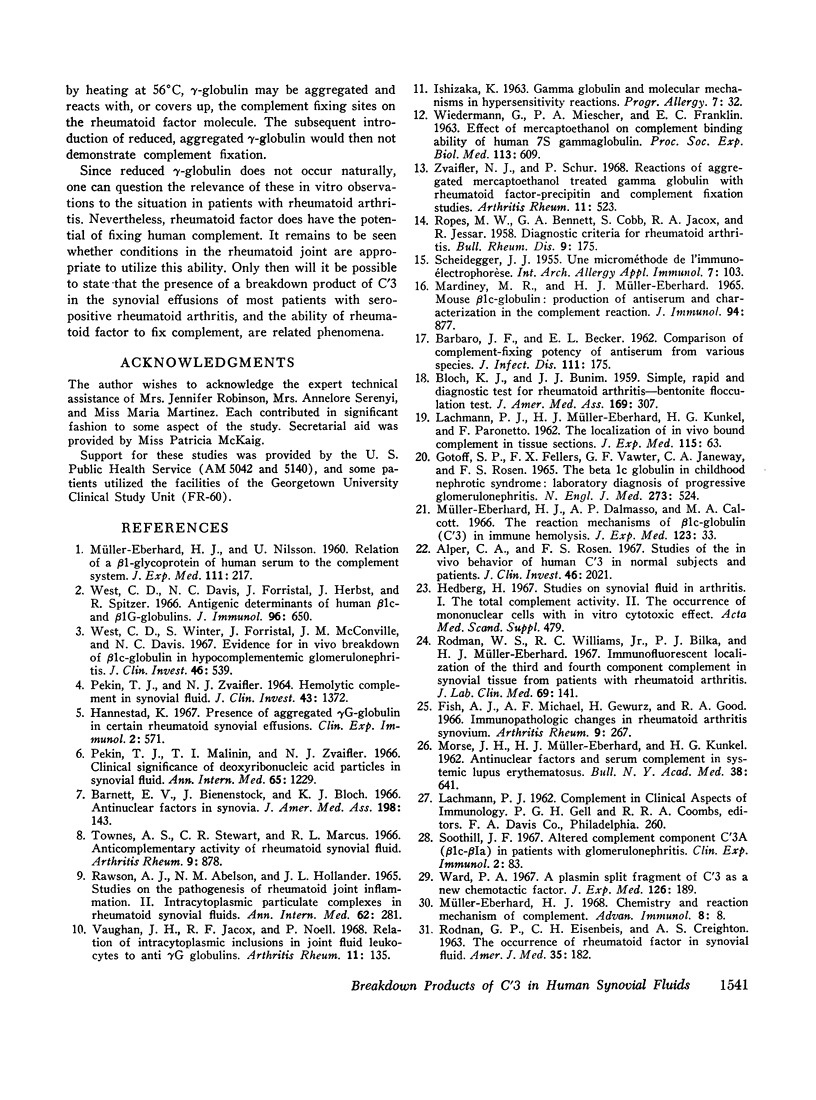
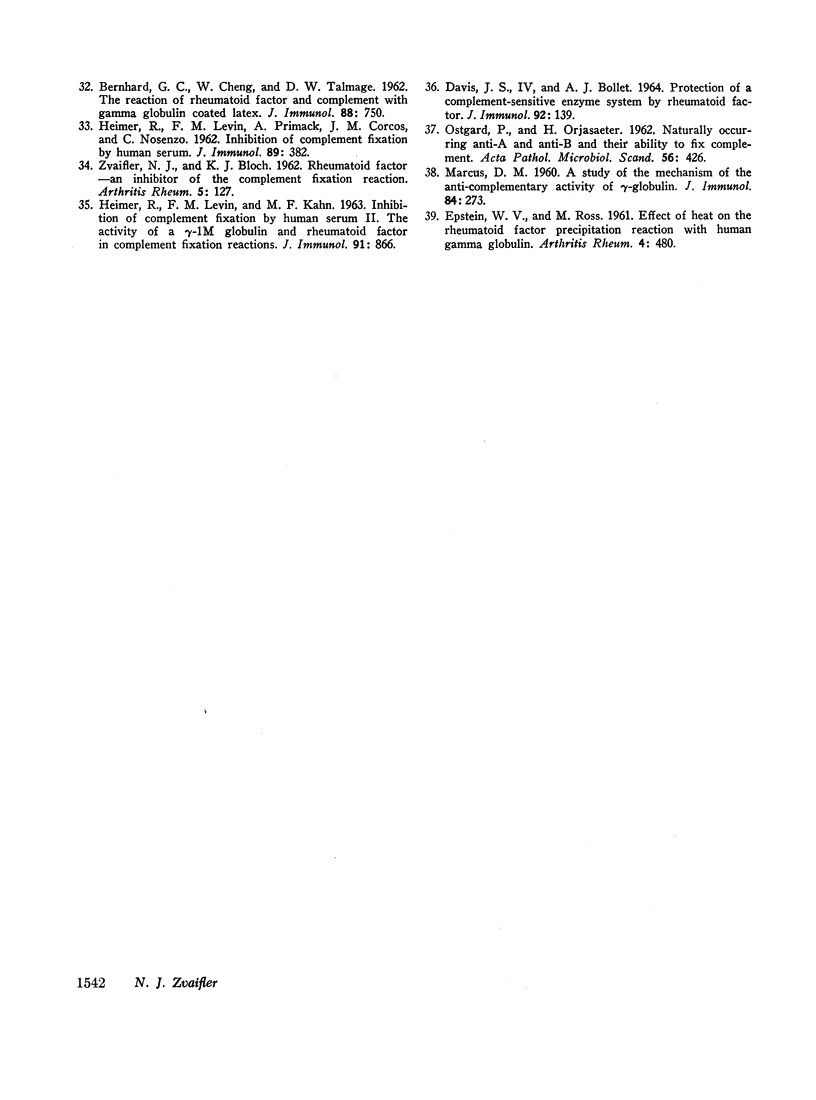
Images in this article
Selected References
These references are in PubMed. This may not be the complete list of references from this article.
- Alper C. A., Rosen F. S. Alper CA, Rosen FS: Studies of the in vivo behavior of human C'3 in normal subjects and patients. J Clin Invest. 1967 Dec;46(12):2021–2034. doi: 10.1172/JCI105691. [DOI] [PMC free article] [PubMed] [Google Scholar]
- BARBARO J. F., BECKER E. L. Comparison of complementfixing potency of antiserum from various species. J Infect Dis. 1962 Nov-Dec;111:175–183. doi: 10.1093/infdis/111.3.175. [DOI] [PubMed] [Google Scholar]
- BLOCH K. J., BUNIM J. J. Simple, rapid diagnostic test for rheumatoid arthritis; bentonite flocculation test. J Am Med Assoc. 1959 Jan 24;169(4):307–314. doi: 10.1001/jama.1959.03000210001001. [DOI] [PubMed] [Google Scholar]
- Barnett E. V., Bienenstock J., Bloch K. J. Antinuclear factors in synovia. Possible participants in the rheumatoid inclusion body. JAMA. 1966 Oct 10;198(2):143–148. [PubMed] [Google Scholar]
- DAVIS J. S., 4th, BOLLET A. J. PROTECTION OF A COMPLEMENT-SENSITIVE ENZYME SYSTEM BY RHEUMATOID FACTOR. J Immunol. 1964 Jan;92:139–144. [PubMed] [Google Scholar]
- EPSTEIN W. V., ROSS M. Effect of heat on the rheumatoid factor precipitation reaction with human gamma-globulin. Arthritis Rheum. 1961 Oct;4:480–489. doi: 10.1002/art.1780040505. [DOI] [PubMed] [Google Scholar]
- GOTOFF S. P., FELLERS F. X., VAWTER G. F., JANEWAY C. A., ROSEN F. S. THE BETA-1C GLOBULIN IN CHILDHOOD NEPHROTIC SYNDROME: LABORATORY DIAGNOSIS OF PROGRESSIVE GLOMERULONEPHRITIS. N Engl J Med. 1965 Sep 2;273:524–529. doi: 10.1056/NEJM196509022731004. [DOI] [PubMed] [Google Scholar]
- HEIMER R., LEVIN F. M., KAHN M. F. INHIBITION OF COMPLEMENT FIXATION BY HUMAN SERUM. II. THE ACTIVITY OF A GAMMA-LM GLOBULIN AND RHEUMATOID FACTOR IN COMPLEMENT FIXATION REACTIONS. J Immunol. 1963 Dec;91:866–872. [PubMed] [Google Scholar]
- HEIMER R., LEVIN F. M., PRIMACK A., CORCOS J. M., NOSENZO C. Inhibition of complement fixation by human serum. J Immunol. 1962 Sep;89:382–390. [PubMed] [Google Scholar]
- ISHIZAKA K. Gamma globulin and molecular mechanisms in hypersensitivity reactions. Prog Allergy. 1963;7:32–106. [PubMed] [Google Scholar]
- LACHMANN P. J., MULLER-EBERHARD H. J., KUNKEL H. G., PARONETTO F. The localization of in vivo bound complement in tissue section. J Exp Med. 1962 Jan 1;115:63–82. doi: 10.1084/jem.115.1.63. [DOI] [PMC free article] [PubMed] [Google Scholar]
- MARCUS D. M. A study of the mechanism of the anticomplementary activity of gamma-globulin. J Immunol. 1960 Mar;84:273–284. [PubMed] [Google Scholar]
- MARDINEY M. R., Jr, MUELLER-EBERHARD H. J. MOUSE BETA-1C-GLOBULIN: PRODUCTION OF ANTISERUM AND CHARACTERIZATION IN THE COMPLEMENT REACTION. J Immunol. 1965 Jun;94:877–882. [PubMed] [Google Scholar]
- MORSE J. H., MULLER-EBERHARD H. J., KUNKEL H. G. Anti-nuclear factors and serum complement in systemic lupus erythematosus. Bull N Y Acad Med. 1962 Oct;38:641–651. [PMC free article] [PubMed] [Google Scholar]
- Müllerèberhard H. J., Dalmasso A. P., Calcott M. A. The reaction mechanism of beta-1C-globulin (C'3) in immune hemolysis. J Exp Med. 1966 Jan 1;123(1):33–54. doi: 10.1084/jem.123.1.33. [DOI] [PMC free article] [PubMed] [Google Scholar]
- OSTGARD P., ORJASAETER H. Naturally occurring anti-A and anti-B and their ability to fix complement. Acta Pathol Microbiol Scand. 1962;56:426–434. [PubMed] [Google Scholar]
- PEKIN T. J., Jr, ZVAIFLER N. J. HEMOLYTIC COMPLEMENT IN SYNOVIAL FLUID. J Clin Invest. 1964 Jul;43:1372–1382. doi: 10.1172/JCI105013. [DOI] [PMC free article] [PubMed] [Google Scholar]
- Pekin T. J., Jr, Malinin T. I., Zvaifler N. J. The clinical significance of deoxyribonucleic acid particles in synovial fluid. Ann Intern Med. 1966 Dec;65(6):1229–1236. doi: 10.7326/0003-4819-65-6-1229. [DOI] [PubMed] [Google Scholar]
- RAWSON A. J., ABELSON N. M., HOLLANDER J. L. STUDIES ON THE PATHOGENESIS OF RHEUMATOID JOINT INFLAMMATION. II. INTRACYTOPLASMIC PARTICULATE COMPLEXES IN RHEUMATOID SYNOVIAL FLUIDS. Ann Intern Med. 1965 Feb;62:281–284. doi: 10.7326/0003-4819-62-2-281. [DOI] [PubMed] [Google Scholar]
- RODNAN G. P., EISENBEIS C. H., Jr, CREIGHTON A. S. THE OCCURRENCE OF RHEUMATOID FACTOR IN SYNOVIAL FLUID. Am J Med. 1963 Aug;35:182–188. doi: 10.1016/0002-9343(63)90209-2. [DOI] [PubMed] [Google Scholar]
- ROPES M. W., BENNETT G. A., COBB S., JACOX R., JESSAR R. A. 1958 Revision of diagnostic criteria for rheumatoid arthritis. Bull Rheum Dis. 1958 Dec;9(4):175–176. [PubMed] [Google Scholar]
- Rodman W. S., Williams R. C., Jr, Bilka P. J., Müller-Eberhard H. J. Immunofluorescent localization of the third and the fourth component of complement in synovial tissue from patients with rheumatoid arthritis. J Lab Clin Med. 1967 Jan;69(1):141–150. [PubMed] [Google Scholar]
- SCHEIDEGGER J. J. Une micro-méthode de l'immuno-electrophorèse. Int Arch Allergy Appl Immunol. 1955;7(2):103–110. [PubMed] [Google Scholar]
- Soothill J. F. Altered complement component C3A (beta-1C--beta-1A) in patients with glomerulonephritis. Clin Exp Immunol. 1967 Jan;2(1):83–92. [PMC free article] [PubMed] [Google Scholar]
- Vaughan J. H., Jacox R. J., Noell P. Relation of intracytoplasmic inclusions in joint fluid leukocytes to anti-gamma-G globulins. Arthritis Rheum. 1968 Apr;11(2):135–144. doi: 10.1002/art.1780110203. [DOI] [PubMed] [Google Scholar]
- WIEDERMANN G., MIESCHER P. A., FRANKLIN E. C. Effect of mercaptoethanol on complement binding ability of human 7 S gammaglobulin. Proc Soc Exp Biol Med. 1963 Jul;113:609–613. doi: 10.3181/00379727-113-28440. [DOI] [PubMed] [Google Scholar]
- Ward P. A. A plasmin-split fragment of C'3 as a new chemotactic factor. J Exp Med. 1967 Aug 1;126(2):189–206. doi: 10.1084/jem.126.2.189. [DOI] [PMC free article] [PubMed] [Google Scholar]
- West C. D., Winter S., Forristal J., McConville J. M., Davis N. C. Evidence for in vivo breakdown of beta-10-globulin in hypocomplementemic glomerulonephritis. J Clin Invest. 1967 Apr;46(4):539–548. doi: 10.1172/JCI105555. [DOI] [PMC free article] [PubMed] [Google Scholar]
- West C., Davis N. C., Forristal J., Herbst J., Spitzer R. Antigenic determinants of human beta-1c and beta-1g-globulins. J Immunol. 1966 Apr;96(4):650–658. [PubMed] [Google Scholar]
- Zvaifler N. J., Schur P. Reactions of aggregated mercaptoethanol treated gamma globulin with rheumatoid factor--precipitin and complement fixation studies. Arthritis Rheum. 1968 Aug;11(4):523–536. doi: 10.1002/art.1780110402. [DOI] [PubMed] [Google Scholar]




